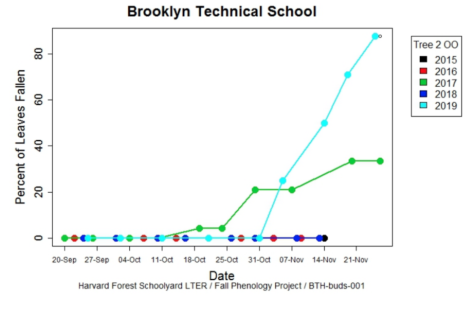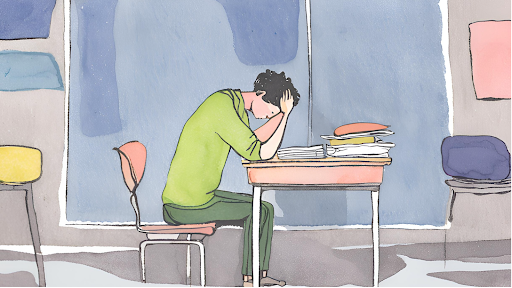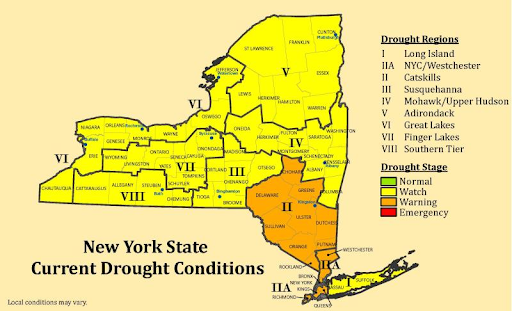The Future of Nature
Brooklyn Tech Environmental Science teachers and students shared their recent research regarding the increase of trees’ growth seasons in Fort Greene Park, causing a dangerous state of imbalance in the ecosystem.
 Dr. Margarita, an Environmental Science teacher at Brooklyn Tech, is conducting an ongoing, six-and-a-half-year-old forest phenology study on the trees at Fort Greene Park with the Environmental Science major and elective. She observes the growing seasons of the trees with her students and concludes whether the growing season is impacted by climate change. The study was inspired by Phenology of Wood Species, a 31-year-old project orchestrated by John O’Keefe, the museum coordinator at Harvard Forest. The project involves observing the timing of leaf emergence on native trees during fall and spring.
Dr. Margarita, an Environmental Science teacher at Brooklyn Tech, is conducting an ongoing, six-and-a-half-year-old forest phenology study on the trees at Fort Greene Park with the Environmental Science major and elective. She observes the growing seasons of the trees with her students and concludes whether the growing season is impacted by climate change. The study was inspired by Phenology of Wood Species, a 31-year-old project orchestrated by John O’Keefe, the museum coordinator at Harvard Forest. The project involves observing the timing of leaf emergence on native trees during fall and spring.
Tenzin Dolkar (‘22), an Environmental Science student involved with the study during the 2020-2021 school year, described the process of conducting research: “We would have weekly sessions where we would go to Fort Greene Park and examine a few branches and their development from several different species of trees. We would take further notes on the weather or any other important information.”
During spring, the leaf buds burst, and the leaves begin to grow. This phenomenon is known as spring phenology, and it is fundamental for tracking the effects of climate change. Spring phenology is solely dependent on fall weather, spring weather and the amount of daylight flora receive.
Dr. Margarita and the Environmental Science students adopted nine trees from Fort Greene Park over the past six and a half years. The majority are noted to be dying or are affected by climate change. “We have a black cherry tree in our study which is susceptible to climate change stress. The older Elm trees in the park are stressed, and the original Horse Chestnut Trees surrounding the park are dying off. The trees that are most stressed in our study are classified under the Green Ash family. Green Ash has been under attack since the 1990s from an invasive species Emerald Ash Borer, but our Green Ash is not infected by Emerald Ash Borer, rather it is showing signs of stress… In general the trees are under a lot of stress from increased human activity, soil compaction, air quality, and flash flooding downpours,” she said.
Through their studies, students have found that the phenology research intersects with land use and forest cover changes. Based on the changes, students can observe how forests are adapting and responding to climate change.
Jolie Kwow (‘20), an Environmental Science Major student involved with the study in the 2019-2020 school year, emphasized the importance of the tree study: “By studying and recording the leaf length, leaf drop, and bud bursts dates, overtime, this will add on to a much larger picture specifically how disturbance of a tree’s normal growth is attributed to climate change.”

The graph above depicts the sharp increase in leaf drops, meaning that the growing season is being negatively affected due to climate change. As this change continues, trees will continue to struggle to survive. Kwow explained, “This large change, from approximately 30% to 90% of leaves dropping by November 21st is alarming. If leaves drop at a higher rate at the same time, the growing season is extended. The tree in 2017 still had time to reach the 50% leaf drop level, yet the 2019 Osage Orange has surpassed this, already well into its growing phase.”
Kwow continued, “Climate change has been blurring the lines between the seasons. We now have milder winters, weaker autumns, and summer seems to be leaking into every month of the year which disentiviezs trees to drop their leaves in the winter. A seemingly small consequence of climate change, this can lead to rather catastrophic results.”
According to Dr. Matthias Schleuning of the Senckenberg Biodiversity and Climate Research Centre article in Science Daily, he speculates that species will either die off or become endangered. Slowly, it will throw the entire ecosystem off in a chain effect.
Kwow elaborates on this claim, “Climate change can threaten the lives of many trees, and by studying these three factors (leaf length, leaf drop, and bud burst dates), we can begin to better understand the extent and severity of climate change.”
Although the environment is facing serious issues from climate change, actions such as gardening can help save the environment.
One particular organization, the BTHS Green Thumb Club, focuses on gardening and educating Tech students about nature.
Loverly Rios (‘23), secretary of the BTHS Green Thumb Club, expressed, “Gardening is a convenient, safe, and relatively easy way to save the environment. While, of course, not everyone has an outdoor garden, it is just as easy to start an indoor one. You can always also take a trip to your local community garden to help out there.”
Rios elaborated, “Gardening has many immediate environmental benefits as well. Plants strengthen the soil with their roots and replenish the soil when they die. They take in CO2 from the atmosphere and replace it with life-sustaining oxygen. They support the activities of insects and pollinators. Processes such as composting and mulching transform waste products into valuable materials that can be recycled into our own gardens and green spaces. By planting majestic trees and fragrant flowers, instead of taking something away from the natural world, we are adding and tending to something precious and beautiful.”
Reducing negative environmental impacts isn’t only limited to gardening; gardening is just one of the many ways of going green to benefit the environment. Other options include but are not limited to: being more sustainable, shopping wisely and reducing pollution.

Michelle Zheng (she/her) is the Senior Executive Editor and a Co-Editor of STEM. Michelle joined The...





































